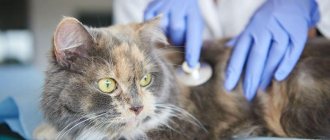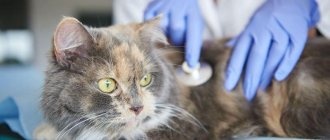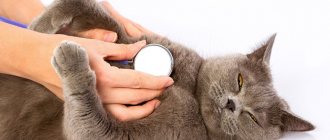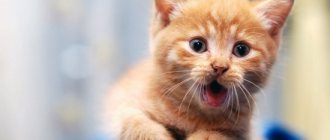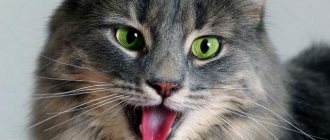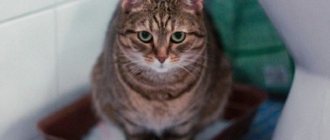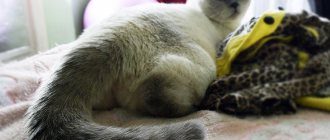The main marker of a cat's health is the animal's activity, and its breathing pattern is the second most important indicator of a cat's well-being. Violation of the usual rhythm of inhalation and exhalation for a particular pet becomes the basis for an emergency visit to the veterinarian.
Let's find out why cats' breathing becomes frequent or heavy, and what to do in such cases.
Rapid breathing as a variant of the physiological norm
A healthy cat inhales and exhales air silently. The system of supplying the animal's body with oxygen works imperceptibly; outwardly this is manifested only in uniform movements of the chest muscles.
Most adult healthy cats take approximately 30 breaths per minute, this amount corresponds to the norm - 20-40 times. The respiratory rate of kittens is slightly higher. It is about 50 breaths in 60 seconds.
What causes a healthy cat to breathe quickly?
Most often, this state of the pet is accompanied by an increased emotional background. There are many reasons that cause rapid breathing in a healthy cat.
Among them:
- unexpected fear;
- overexcitement;
- stress;
- dehydration;
- active games;
- meeting a dog;
- overheat;
- labor, prenatal period;
- excited state during mating.
Difficulty or rapid breathing in such situations is considered normal. After some time, the cat’s rhythm of inhalation and exhalation evens out, she calms down and begins to breathe as always.
Why does a kitten breathe quickly when sleeping?
Kittens, like all babies, are more mobile than adult animals. This is associated with their accelerated metabolism, increased reflexes, and rapid breathing rhythm. When a cat often breathes from his stomach after active games, this is considered normal, but if he is not eating well, you should take a closer look at the baby.
Inexperienced owners do not always understand what to do if the kitten is breathing very quickly. First of all, you need to evaluate the animal’s appearance, behavior, and breathing patterns. If the kitten meows hoarsely or wheezes, and mucus comes out of the animal’s nose, the baby needs treatment.
Some kitten owners worry when their pet breathes strangely in its sleep. In such a situation there is no need to worry. Cats see dreams and react to them in the same way as to real events. Very rarely do they sleep without dreams. Frequent breathing during sleep is a sign of emotional distress.
Basic information
Rapid breathing is caused by the following reasons:
- Surgery, including sterilization. In this way (by increasing heart rate and breathing), the cat’s body tries to recover after the administration of medications. The frequency and depth of breaths may be disrupted, and then level off on their own. If the lips, gums and nose begin to turn blue, the cardiovascular or respiratory system is affected. The cat needs qualified veterinary care;
- Overheating of the animal, including after physical activity. Unlike humans, cats do not have sweat glands. Therefore, tachypnea occurs when the animal tries to cool down. At the same time, the cat sticks out its tongue and breathes briefly and frequently.
- Okot. Childbirth is a strong stress for the body, which can cause rapid breathing. After giving birth, your cat may not need help if her breathing returns to normal over time.
- Severe fright or stress can cause emotional distress in a cat. In addition to external signs (severe fear and pinned ears), hidden ones (pain) are also added. In addition, the animal can show aggression - attack or hide.
- Pathologies of internal organs, leading to an increase in the size of these organs, increased abdominal pressure, ascites, diseases of the heart, blood, lungs and endocrine disorders.
Pathological causes of tachypnea
Sometimes a cat breathes heavily because it is sick. The number of breaths per minute increases noticeably, the mouth is open, the sides rise and fall heavily. The cat seems to be short of air. In some cases this is what happens. For example, when a furry pet develops asthma.
Pathological causes of rapid breathing in a cat can be:
- blood diseases;
- ascites (excess fluid in the abdominal cavity);
- development of various myalgia (heart pathologies);
- airway spasm;
- lung diseases;
- increased pressure inside the abdominal cavity;
- foreign object inside the respiratory tract, trachea or bronchi;
- malignant neoplasms;
- painful growth of some organs.
Important! If a cat has difficulty breathing, only a specialist can determine the exact cause of the animal’s strange condition. Self-diagnosis is usually wrong. This results in the loss of valuable time for treating the pet.
If there is a suspicion that a cat has developed a respiratory pathology, experts advise paying attention to the appearance of the animal. If your cat's ears are flattened, he is overexcited, attacks or tries to hide, he may be under stress.
A frightened or irritated cat almost always breathes from its belly. But as soon as he calms down, breathing returns to normal. There is no need to treat such an animal.
Risk group
There are cat breeds that are prone to breathing problems. These animals were bred using multi-level selection, focusing on the most beautiful appearance. The result was a phenotype with characteristic features of the skull shape. This negatively affected the internal structure of some organs of the respiratory system. Such cats were called brachycephalic.
Persian, Himalayan, British, exotic and Scottish cats have wide muzzles, a characteristic nose shape, the larynx, trachea and jaw of animals are disproportionate to the length of the tongue. This combination is called brachycephalic syndrome (BAOS).
If your cat is brachycephalic, you need to handle him especially carefully, making sure that the animal does not overheat or become physically overtired. Such cats were unlucky from birth: their narrowed nasal openings are not able to ensure normal breathing. To inhale, animals exert certain efforts, which cause an even greater narrowing of the lumens of the nostrils. The airways are pulled inward.
Difficulty inhaling leads to stretching of the animal's laryngeal mucosa. The trachea of brachycephals is initially narrowed, and the palate is longer than that of an ordinary cat. All this negatively affects the functioning of the lungs and increases the load on the heart.
Moments of tension, sometimes even ordinary games, cause sniffling, bubbling in the chest, and coughing in brachycephalic pets. It is impossible to miss such symptoms. They signal the onset of the disease. This is the case when physical abnormalities sooner or later lead to illness.
Important! If a cat develops characteristic breathing difficulties, you should immediately take your pet to a veterinarian. Delay in the visit causes an increase in negative symptoms in the animal.
Respiratory system diseases
When a cat breathes from its belly, there are signs that its lungs are not receiving enough oxygen. The cause may be an infectious-inflammatory disease of the respiratory tract.
As a rule, furry pets get sick:
- rhinitis;
- tracheitis;
- bronchitis.
The cat's body actively fights infectious agents. Mucus is secreted, which contains many leukocytes. This is a normal reaction of the animal's immune system. However, mucus in the respiratory tract interferes with the normal process of obtaining oxygen, so the cat (or kitten) often breathes from its stomach.
A sick pet coughs and mucus comes out of its nose. As a rule, this is accompanied by high fever and an unpleasant odor from the patient’s mouth. The kitten is lethargic and suffers from diarrhea and vomiting. Ulcers form on the oral mucosa. A sick animal begins to wheeze and wheeze when breathing, cough, and sneeze.
Important! If the kitten is breathing heavily and its condition does not return to normal within a few hours, a visit to the veterinarian is required.
Non-infectious causes
It happens that a cat is breathing heavily due to an illness that is not associated with infection. For example, these could be problems with the soft palate or larynx (spasm, swelling).
Abdominal breathing syndrome is caused by the following pathologies:
- helminthiases;
- accumulation of fluid inside the chest cavity (hydrothorax);
- hiatal hernia;
- accumulation of air in the chest cavity (pneumothorax);
- inflammation of the sinuses.
Important! If, a few days after the operation, the cat continues to have difficulty breathing, the animal suffers from shortness of breath, it is necessary to urgently call a doctor. It would also be a good idea to check the condition of your pet’s gums, lips and nose. A bluish tint to the surfaces indicates the development of complications in the heart or respiratory system.
Diseases that are not associated with pathologies of the respiratory system
If a cat has damage to the spine, sternum or ribs, he will have difficulty standing up and try not to strain his chest by breathing. An injured animal breathes shallowly (through the stomach). He develops shortness of breath.
In this state, the cat does not allow you to touch the sore spots, meows loudly, and sometimes loses consciousness. He should be taken to the clinic urgently. Most injuries can only be treated with surgery.
Myalgia
Some cat breeds are predisposed from birth to developing cardiovascular pathologies. These are Maine Coons, British and Persian pets. But other members of the cat family often suffer from heart disease.
The first symptom of the development of myalgia in a cat is abdominal breathing. Then wheezing appears, the skin on the body turns pale, and the mucous membranes in the mouth become blue.
The cat is lethargic, does not eat anything, lies constantly, and breathes heavily. The animal quickly weakens, its heart beats strongly even in the absence of physical activity.
Important! If your cat is diagnosed with heart failure, you will need to give her an injection of a prescribed drug when an attack occurs. Then take it out into the fresh air.
The owner of a cat suffering from myalgia must be prepared to provide emergency assistance if breathing stops during an attack. Vigorously blowing air into the nose through cupped palms will help.
The effectiveness of assistance will increase if artificial respiration is alternated with chest compressions. But it’s best to have the doctor’s phone number handy.
Overheating
Sometimes the cat pant frequently due to the heat. If immediate action is not taken, the animal may suffer from heatstroke. Signs of overheating are:
- Temperature more than 40 degrees.
- Reddened mucous membranes.
- Rapid pulse.
- Predominantly recumbent position of the animal, the cat lies, breathes heavily, sticks out its tongue.
The amount of sweat that is secreted by the skin of a furry pet is unable to cool its body to normal temperature. To reduce body temperature, the cat opens its mouth and breathes heavily. For cats of exotic breeds, British, Scottish, Persian cats, an acceleration of the breathing rhythm in hot weather is considered normal.
Oncology
The clinical picture of this disease depends on the degree of development of the pathology, its type and location. Signs of the disease are:
- loss of appetite;
- decreased physical activity;
- increasing sleep time;
- weight loss.
A sick cat develops shortness of breath and its fur loses its shine. As the tumor grows, the animal wheezes and coughs more and more.
Alcohol poisoning
Some substances containing ethyl alcohol and ethanol, when ingested, have a damaging effect on the human central nervous system. As a result of reactions in the body, ethanol is converted into a combination of acetaldehyde and acetic acid. It is these compounds that affect the internal organs and tissues of the body causing poisoning.
Signs of alcohol poisoning
- impaired coordination of movement (uncertain gait, staggering);
- emotional instability;
- redness of the skin (red face);
- gagging and nausea;
- in severe poisoning, loss of motor activity, impaired consciousness and depression of respiratory function
Ignorance of limits, abuse of alcoholic beverages, and simply poisoning sometimes leads to serious consequences. They are characterized by:
- comatose state with complete loss of consciousness
- decreased pain reflexes
- impairment of human visual functions
Symptoms of this condition are:
- constricted pupils or pupils of different sizes, most often this depends on impaired respiratory function
- slow muscle reactions and reflexes
Experts divide the state of alcoholic coma into two stages. The first stage is characterized by weak reactions to pressure on pain points, injections, and strong odors (ammonia vapor). It is expressed in weak retaliatory attempts to defend oneself with one’s hands and brush them off.
The second stage of alcohol poisoning is characterized by an almost complete lack of reaction to pain, while the pupils practically do not react to light at all.
The development of deep coma during poisoning is characterized by a decrease in all physical activity, reflexes and movement, and a decrease in body temperature. The most dangerous thing is the lack of medical care for respiratory dysfunction in this condition. This is the main cause of death from ethanol poisoning.
The most common phenomena in deep alcoholic coma are:
- profuse salivation
- tongue retraction
- hoarse weak breathing
- nausea (especially dangerous if vomit enters the respiratory tract)
- bluish complexion
- decrease in blood pressure
- rapid heartbeat and poor circulation
First aid
The very first action in case of alcohol poisoning is to call an ambulance. If the victim reacts to external influences, he is clearly inhibited in his actions and drowsiness, it is necessary to put a cloth soaked in ammonia under his nose and, if possible, rinse his stomach.
To rinse your stomach, you need to drink a lot of water with the addition of baking soda, at least a liter. Next, you should put two fingers in your mouth to trigger a gag reflex.
During alcohol consumption, the superficial blood vessels of the skin cool, so after gastric lavage, you need to warm the victim.
If you have activated carbon or other adsorbent agent, it would be a good idea to give it to the victim. Take activated carbon at the rate of 1 tablet per 10 kg of weight.
If the victim does not respond to external stimuli and is in a comatose state, it is necessary to turn him on his stomach to avoid vomit from entering the respiratory tract.
Associated symptoms
When a cat is brought to the doctor, first of all he asks about the signs that alerted the owner of the animal. Therefore, monitoring a presumably sick pet before visiting the clinic is very important. This helps to quickly make a diagnosis.
Signs that accompany the development of pathology of the respiratory system are:
- poor appetite;
- wheezing when breathing;
- increased heart rate;
- elevated temperature;
- rapid pulse;
- redness or bluish tint of the mucous membranes;
- vomit;
- swelling;
- diarrhea;
- the appearance of mucous discharge from the mouth or nasal openings.
The effectiveness of treatment for your pet depends on the amount of time that has passed since the onset of alarming symptoms. There are diseases that develop very quickly. For example, pulmonary edema. Delay in such cases can cost the pet’s life.
What should an owner do if a cat is breathing frequently?
The owner of the animal should first determine the nature of the causes of tachypnea. To do this, you need to compare the condition, appearance and behavior of the pet. Based on observations, we can draw a conclusion about the physiological or pathological causes of the animal’s condition.
In the first case (active games, stress), you should simply give the cat time to restore its normal breathing rhythm. Conditions are created for the animal's peace and comfort. For example, if a cat overheats, be sure to give it something to drink and cool the areas of large vessels (armpits, belly, paw pads).
If you suspect a pathology, you should carefully examine the animal, check the integrity of the ribs and limbs. If an injury is detected, you need to quickly take the cat to the doctor.
A veterinarian’s consultation and treatment will be needed in any case if the animal’s condition does not improve within 3 hours, and the cat’s heavy breathing is accompanied by pathological symptoms. If tachypnea persists without physical exertion, overheating or stress, the animal must be examined by a specialist.
When is a vet visit necessary?
If you have certain symptoms, it is better not to waste time on self-examination. These include:
- rapid deterioration of the condition or lack of improvement within 3 hours;
- severe wheezing and gurgling in the chest;
- the appearance of pain when touching or coughing, accompanied by a plaintive meow;
- copious discharge of mucus from the nose or mouth;
- pale or blue discoloration of the skin and mucous membranes;
- increase or decrease in heart rate;
- convulsions;
- loss of consciousness.
Particular attention should be paid to children, elderly and pregnant animals. If the kitten is breathing heavily, then it should be taken to the veterinary clinic even in the absence of the listed symptoms. Due to fragile immunity, pets often get sick with complications up to a year old, so in such a situation it is better to play it safe.
In addition to visual inspection and palpation (palpation), a blood test, ultrasound, x-ray and ECG may be required to make a diagnosis. The list of medications will depend on the pathology found:
- antibiotics and antivirals that fight infectious agents;
- anthelmintics that destroy parasites;
- cardiotonics and vasopressors, which reduce the volume of circulating blood and increase the force of heart contraction;
- diuretics, facilitating the removal of excess fluid;
- glucocorticosteroids, eliminating allergies and inflammatory processes;
- sorbents that stimulate the removal of toxins.
In case of poisoning, an antidote may be required. Surgery is used when injuries, deep-lying foreign bodies and neoplasms are detected. If at the time of treatment the cat is in serious condition, then it can be placed in an oxygen chamber.
Diagnostic measures
A loving owner always knows the normal breathing rate of his cat. It is slightly different for each animal. Such indicators are determined individually, in the process of observing a calm cat.
Home diagnostics of a pet's breathing is carried out when the animal lies on its side, its stomach rises (inhale) and falls (exhale) steadily. It is necessary to count how many breaths are taken in 1 minute. The counting is repeated 2–3 times. Average values are considered normal for this cat.
The respiratory rate of the animal is compared with the obtained figures when there is a suspicion of disease. This diagnosis determines the severity of the cat’s condition and helps the veterinarian in identifying pathology.
Professional
After talking with the cat owner and examining the animal, the veterinarian sends the furry patient for tests. As a rule, the following are required: biochemical blood data, ultrasound (heart, chest), X-ray results of the neck, chest. If you suspect anemia or diabetes, you will need to test your pet's urine.
Advanced diagnostics include studies of the animal’s bronchi, CT, and rhinoscopy. Sometimes hormonal tests are also necessary.
When diagnosing pathology, the exclusion method is used. This means that from all possible diagnoses diseases that do not coincide with the test data of the furry patient are excluded.
Treatment methods
Viral respiratory tract infections in cats are treated with antibiotics, immunomodulators, antiviral and anti-inflammatory drugs, and vitamins. Therapy is aimed at relieving the symptoms of the disease and preventing complications.
If a cat is diagnosed with trauma or cancer, surgical intervention is most often used. About half of the time a foreign body in the airway causes a foreign body to see a doctor, surgery is also required. Sometimes a cat's difficulty breathing, which is associated with a malignant tumor, is restored with the help of chemical or radiation therapy. In other cases, the doctor prescribes medication.
It happens that a cat breathes heavily with his mouth open and does not eat after undergoing surgery. This condition is part of the body's recovery process from the effects of medications.
Not all cats tolerate narcotic anesthesia easily. If it is determined that the cause of the cat's breathing jerks is pain or intoxication after anesthesia, the doctor gives the animal an anesthetic and prescribes a course of treatment. After some time, the animal’s breathing is restored.
